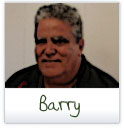 language & literacy
language & literacy
Many of the learners who contributed their stories about learning for this project come from communities in the Northern Territory where Indigenous languages are spoken widely, and where English is only used in interactions with non-Indigenous people and with government agencies. Many of these learners identified their struggle to develop English literacy and numeracy skills in their school education and the limitations this placed on their participation in further education and training. It is of critical importance that the vocational education and training system supports the development of these skills as 'people with higher literacy and numeracy skills are more likely to participate in the workforce, be employed in more highly skilled jobs and earn more, compared with people who have lower skills'1.
In the following section learners and trainers share their experiences and their ideas about Indigenous languages and English, literacy and numeracy in vocational education,in workplace training and in other learning environments.
1 Shomos, A (2010) Links between literacy and Numeracy Skills and Labour Market Outcomes: Productivity Commission Staff Working Paper.
- What the learners say
- What the trainers say
Leisa
 Leisa is employed in the nursery in an Indigenous community. On the job training is provided by the workplace supervisor.
Leisa is employed in the nursery in an Indigenous community. On the job training is provided by the workplace supervisor.
Leisa talks about her desire to learn to read and write
Don
 Don is a qualified mechanic. He has worked in this role for over 30 years in an Indigenous community.
Don is a qualified mechanic. He has worked in this role for over 30 years in an Indigenous community.
Don talks about English language and translation
Don talks about the need for literacy support
Elizabeth
 Elizabeth is employed as a machinist in a textile art business in an Indigenous community. On the job training is provided by the workplace supervisor.
Elizabeth is employed as a machinist in a textile art business in an Indigenous community. On the job training is provided by the workplace supervisor.
Elizabeth talks about her own level of literacy
Heleana
 Heleana is a trainee teacher and is enrolled in a Bachelor of Teaching and Learning. She previously worked in the areas of land management and eco-cultural tourism. She has completed the Certificates II and III in Spoken and Written English and is completing her final units in a tertiary preparation course concurrently with her teaching studies.
Heleana is a trainee teacher and is enrolled in a Bachelor of Teaching and Learning. She previously worked in the areas of land management and eco-cultural tourism. She has completed the Certificates II and III in Spoken and Written English and is completing her final units in a tertiary preparation course concurrently with her teaching studies.
Heleana talks about English language and early education
Heleana - time to educate myself in literacy and numeracy
Heleana - learning Balanda literacy using Indigenous ways
Heleana talks about English language
Victor
 Victor is a ranger supervisor in an Indigenous community. He has previously completed Certificate III in Conservation and Land Management.
Victor is a ranger supervisor in an Indigenous community. He has previously completed Certificate III in Conservation and Land Management.
Victor talks about literacy as a big brick wall
Ivan
 Ivan is a ranger in an Indigenous community. He is currently enrolled in Certificate II in Conservation and Land Management.
Ivan is a ranger in an Indigenous community. He is currently enrolled in Certificate II in Conservation and Land Management.
Ivan talks about difficulties learning in english
Nardene
 Nardene is the current Vice-Chancellors Indigenous Career Cadet at Charles Darwin University. She is studying a Bachelor of Commerce specialising in marketing. She previously completed a Certificate IV in Marketing and a Certificate IV in Community Services.
Nardene is the current Vice-Chancellors Indigenous Career Cadet at Charles Darwin University. She is studying a Bachelor of Commerce specialising in marketing. She previously completed a Certificate IV in Marketing and a Certificate IV in Community Services.
Nardene talks about strategies that supported the development of her literacy skills
Nardene talks about the importance of tutors to assist with literacy development
Michael
 Michael is a VET lecturer in Conservation & Land Management. He has extensive experience working with and training Indigenous rangers.
Michael is a VET lecturer in Conservation & Land Management. He has extensive experience working with and training Indigenous rangers.
Michael talks about how he supports learners with low levels of literacy
Debbie
 Debbie is the workplace supervisor and trainer in a textile art business in an Indigenous community.
Debbie is the workplace supervisor and trainer in a textile art business in an Indigenous community.
Debbie talks about the importance of language translation to enhance understanding and learning
Debbie talks about numeracy concepts
Andree
 Andree is the workplace supervisor and trainer in horticulture at the nursery in an Indigenous community.
Andree is the workplace supervisor and trainer in horticulture at the nursery in an Indigenous community.
Andree talks about hands on training
Cyril
 Cyril works for the health board in an Indigenous community. One of his roles involves the coordination of work based training for staff.
Cyril works for the health board in an Indigenous community. One of his roles involves the coordination of work based training for staff.
Cyril talks about strategies for making text meaningful
Cyril talks about the doing versus the writing
Fred
 Fred is a VET trainer. He delivers Certificate I in Work Preparation in Indigenous communities. Most training is conducted in the workplace.
Fred is a VET trainer. He delivers Certificate I in Work Preparation in Indigenous communities. Most training is conducted in the workplace.
Fred talks about accommodating students with low literacy and English language skills
Fred talks about giving partial qualifications
Ingrid
 Ingrid is a first-year-out teacher working at a school in an Indigenous community. Prior to completing a Bachelor of Education Ingrid worked for 13 years as an Aboriginal Islander Education Worker.
Ingrid is a first-year-out teacher working at a school in an Indigenous community. Prior to completing a Bachelor of Education Ingrid worked for 13 years as an Aboriginal Islander Education Worker.
Ingrid talks about Indigenous languages
Barry
 Barry is a VET trainer in Indigenous Education Work. He delivers training in the workplace in an Indigenous community.
Barry is a VET trainer in Indigenous Education Work. He delivers training in the workplace in an Indigenous community.
Barry talks about the need to teach literacy skills in context
Barry talks about the links between training and Indigenous languages
Barry questions the status and importance of English language training in Indigenous communities
Barry talks about using Indigenous languages in training
Barry talks about what can happen if training is conducted only in English
Strategies for trainers:
Find out learners' English language, literacy and numeracy skills through discussion and observation and take these into account when planning and delivering training
Allow time in training sessions to focus on building English language, literacy and numeracy skills relevant to the subject
Give clear, practical demonstrations, and repeat them as many times as needed
Allow learners time to practice new skills and become confident at them before moving on to new tasks
Encourage learners to have a go without fear of making mistakes
Tell stories and give examples to illustrate meaning
Read text out loud to students
Model written responses
Scribe student responses and allow students to copy the writing if they can’t yet write independently
Build a supportive environment where learners are encouraged to assist each and work together on reading and writing tasks
Provide opportunities for students to teach each other
Access interpreters, if students need them, to negotiate training and during training
Encourage learners to discuss ideas and concepts in their own language if this assists with making meaning
Learn some of the learner’s language and use it in the classroom
Assist students to identify strategies that help them to learn and remember, such as rhyme
Use clear language that students will understand rather than jargon or ‘public-service speak’
Use large, clear fonts in written texts
Use illustrations to support text
Build a supportive environment where there is no shame in not being able to read and write well
Focus on meeting the needs and tapping into the motivations of the learner
Assess students’ skills by observation or oral questioning when written assessment is not appropriate
Access specialist English language, literacy and/or numeracy support if it is available
